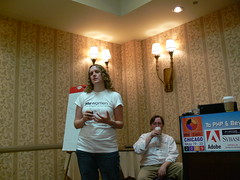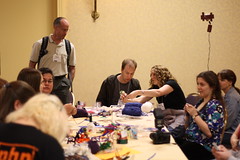The netbook is easily up to this job – it happily runs the open office presenter program, I don’t have the presenter view plugin installed on it yet but just use the screens mirrored and use the netbook screen to see the current slide rather than having to look at the screen. This saves me either having to look away from my audience or from being completely floored by slides WAY too big for me to read when I’m standing in front of them (I presented at the FOWA roadshow, great venue but slides so big I didn’t dare look round at them!). The netbook screen is small but font sizes on slides should be quite big and I’m kind of long sighted so I can read the text at a distance of 6 to 8 feet without an issue.
The presenter mouse has a little USB dongle and then controls for controlling the presentation, with a laser pointer and a button to turn slides to black – once I begin I don’t need to be back within reach of the computer at any point. Which is really useful if you get one of those awkward spaces where the dock for the laptop is in a corner you don’t want to be standing in (I see this a lot at the informal geek events). Just start it going and get into position – and present from there. Of course this relies on knowing the presentation well enough to not need your slides or notes or having a paper copy you can refer to.
Don’t be fooled that you need great hardware or particular equipment to give a talk – anything with a monitor socket to talk to the projector is good enough, and if you can get a remote of some kind then all the better. Other accessories that might help is a stop watch (or use the timer on your phone and put it somewhere you can see it), so you know how you are doing for time, and some notes on index cards that you can easily hold without rustling. Above all, take a step away from your computer and look your audience in the eye – they’re here to see and hear you.




